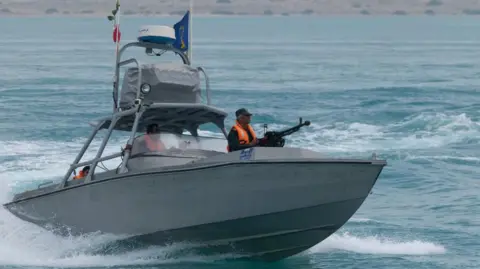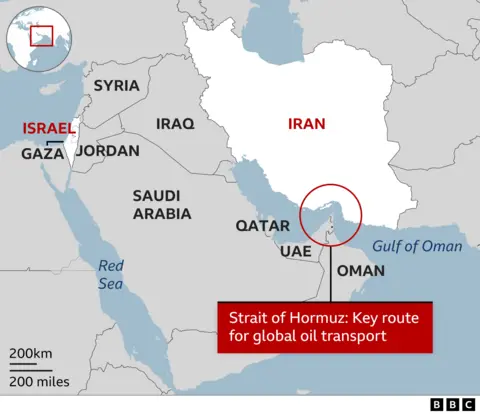 Getti images
Getti imagesThere are significant speculations that Iran could revenge for the strikes of American nuclear facilities by closing the busiest channel for shipping in the world, the streal of the Hormuz.
About 20% of global oil and gas passes through this narrow delivery of the bay bar. Blocking would have profound consequences for the global economy, distracting international trade and scattering oil prices.
It could also leave the costs of goods and services around the world and hit some of the world’s largest economies, including China, India and Japan, which are among the above importers of crude oil that pass through the strait.
What is the Motherchair Hormuz – and where is it?
Ches Hormuza is one of the most important proprietary routes in the world and its most important point of more vital oils.
Oman and south by Oman and South by Oman and United Arab Emirates (UAE), the hallway – which is only about 50 km at its entrance and exit, and about 33 km wide in its width, connects the Bay to the Arabian sea.

Tenca is deep enough for the world’s largest raw oil tankers, and they use main oil and gas producers in the Middle East – and their customers.
In the first half of 2023. About 20 million barrels of oil passed through the strait of Hormuz daily, according to US Energy Administration (EIA) – it is almost 600 billion energy energies per year.
That oil comes not only from Iran, but other Gulf states such as Iraq, Kuwait, Qatar, Saudi Arabia and UAE.
What would be the influence of the closure of the parent nut?
Former Head of the British intelligence agency Mi6, Sir Alek Jali, said to the BBC’s worst scenario in the current Iranian-Israel, included blockade on Hormus’ Surface.
“The closure of Matic would be obviously an incredible economic problem given the effect he would have on the oil price,” he said.
It would be a “vague terrain”, according to Bader Al-Saif, assistant professor at the Kuwait University, which specializes in the Geopolitics of the Arabian Peninsula.
“That would have direct consequences in world markets, because you will see oil price, [and] You will see that the stock exchanges react to what is happening, “said Mr. Al-Saif BBC Newshour.
That, of course, hurt the Bay countries whose economy are very relying on energy exports.
Saudi Arabia, for example, uses a strait for exports about 6 million barrels of crude oil daily – more than any neighboring country – according to the research of analytics company Vorteka.
 Getti images
Getti imagesIran, in comparison, exports about 1.7 million barrels per day, according to the International Energy Agency. Iran was exported in the financial year in the amount of 67 billion dollars, which ended March 2025. – This is the largest oil income in the last decade – according to the estimates of the Iran’s central bank.
And Asia would be hard-hit. In 2022. About 82% of crude oil and condensate (liquid hydrocarbons with low density usually occur with natural gas) leaving strict chormuses are related to Asian countries, in accordance with EIA estimates.
China is only to buy about 90% of oil exported to the global market.
Any disorders to this could increase fuel and production costs at the same time when China must rely on production and export. It is not just a home problem, neither: growing production costs could eventually be transferred to consumers, encouraging inflation worldwide.
Impact can also be grazing for other key asian economies, which are among the largest importers, after China. Almost half of crude oil and 60% of its import of natural gas passes through the strain of the Hormuz. South Korea reportedly received 60% of his crude oil through the nut and Japan almost three.
How could Iran close the nut?
The United Nations Rules allow countries to control up to 12 nautical miles from their coast.
This means that at her wider point, the strait of Hormuz and its shipping straps are completely lying inside Iran and Oman Territorial Waters.
If Iran should try to block 3000 or so ships that sailed through a strait, one of the most effective ways for it, according to experts, would be laid by mines using fast attack boats and submarines.
The regular Navy of Iran and the Islamic Revolutionary Watchman (IRGC) can potentially launch attacks on foreign warships and commercial vessels.
However, large military ships can turn easy targets for American air attacks.
Iranian fast boats are often armed with anti-ship missiles, and the country also works a number of surface courts, semi-use crafts and submarines.
Experts say Iran could temporarily block offs, but many are equally sure that the United States and its allies could quickly establish a flow of maritime traffic by military means.
Now they did it before.
At the end of the 1980s, during the eight-year war, Iraqi Iranian Iraqi oil stroke escalated into “war tankers”, who saw both countries attack neutral ships to achieve economic pressure.
Cuwait tanks carried by Iraqi oil were especially vulnerable – and at the end, American warships started following through the bay in what the largest naval convoy operations from the Second World War.
Will Iran block the nut?
While Iran was repeatedly threatened to close Strait Hormuz in past conflicts, it never followed.
Perhaps the closest call was during the war tanker at the end of the 1980s – but even then, shipping through pressure Hormuz was never seriously disturbed.
If Iran brings his threat, this time could be different.
The US Secretary of State Marko Rubio claimed that Iranian closure of Hormuz Iranian closure of the amount “economic suicide” and He called for China, ally Tehran, to intervene.
“I encourage Chinese government in Beijing to call them [Iran] About this, because they largely depend on the body of the Hormuse for their oil, “Rubio said in interview Fox Nevsion on Sunday.
“We reserve the options to face it, but other countries should also look at that. It would hurt other countries much worse than ours.”
 Getti images
Getti imagesAlthough China has yet to react, Beijing is unlikely to welcome any rose prices or disruption to shipping routes and that it could take advantage of their diplomatic weight to stop the Iranian government to stop blocking.
The energy analyst Vandana Harry said Iran has “a little bit to get too much to lose” from closing the tight nut.
“Iranian risks that neighbors in oil and gas in the bay in enemies and invite their key to China’s disruptive traffic in Strength,” said Harry news of the BBC.
Can alternative routes make up with a blockade?
The lasting threat of the closure of the horizons for closing the hormle, over the years, the oil exporters in the Gulf region for years to develop alternative export routes.
According to the EIA report, Saudi Arabia activated its gas pipeline East-west, length of 1,200km long, capable of transporting up to 5m crude oil barrels per day.
In 2019, Saudi Arabia temporarily rejected the natural gas oil pipeline for carrying crude oil.
The United Arab Emirates connected its internal oil in the Lujairah Port to the Bay of Oman via the pipeline with a daily capacity of 1.5 million barrels.
In July 2021. Iran opened the Niphoppipe for Gorah-Jaskia, he intended to move crude oil in Oman Bay. This pip drive can currently carry about 350,000 barrels per day – although reports suggest Iran yet.
EIA estimates that these alternate routes could be carried by about 3.5 million barrels of oil per day – approximately 15% of the crude raw are raw blue winds that are currently delivered through the strait.






